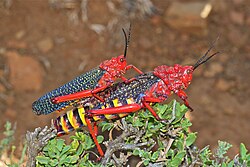| Pyrgomorphidae | |
|---|---|
 | |
| Pyrgomorpha conica , a well-camouflaged species | |
 | |
| Phymateus morbillosus, a toxic species with bright warning colours | |
| Scientific classification | |
| Kingdom: | Animalia |
| Phylum: | Arthropoda |
| Class: | Insecta |
| Order: | Orthoptera |
| Suborder: | Caelifera |
| Superfamily: | Pyrgomorphoidea |
| Family: | Pyrgomorphidae Brunner von Wattenwyl, 1874 |
| Subfamilies and Tribes | |
See text | |
Pyrgomorphidae is a family of grasshoppers in the order Orthoptera; it is the only family in the superfamily Pyrgomorphoidea. [1] Pyrgomorphidae are found worldwide in tropical and warm temperate regions (though none are from US mainland), [1] but the vast majority of the family's approximately 500 species are from Africa, Asia and Australia. [2] Their name is probably derived from pyrgos (Greek: Πύργος) meaning "tower": a reference to the form (morph) of the head in the type genus Pyrgomorpha and other genera.
Contents
They may sometimes be known as "gaudy grasshoppers", [1] due to the striking, bright aposematic colouration of a number of genera, warning of their toxicity. [2] However, about 90% of the species in the family are harmless and well-camouflaged, [2] with a few, notably Sphenarium , even caught for human consumption. [3]




